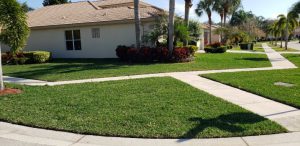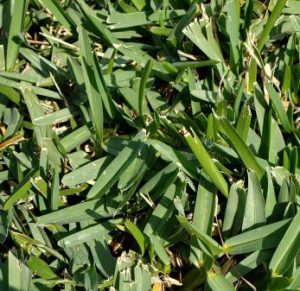Lethal Viral Necrosis (LVN) of Floratam St. Augustinegrass, caused by Sugarcane Mosaic Virus is a severe and very expensive landscape issue in southeastern Florida. It is also widespread in Pinellas County, Florida and occurs less frequently in a few other areas of the state.
The UF/IFAS developed, CitraBlue St. Augustinegrass is a very promising cultivar for use in Florida; however, more time and data are needed to confirm its use for replacement of Floratam in LVN affected landscapes. CitraBlue St. Augustinegrass is the only landscape turfgrass available in Florida that is currently in an accredited certification program.
Certification of Sod
Nationally, certification of seed and sod grasses is governed by AOSCA (Association of Official Seed Certifying Agencies). Many states will have a certifying agency that is a member of AOSCA. In Florida, the Southern Seed Certification Association (SSCA) is the agency that inspects and certifies sod fields. They are non-governmental, and therefore are not part of the Florida Department of Agriculture and Consumer Services. Other St. Augustinegrass cultivars are not certified in Florida. Text on SSCA’s website states that they are “a non-profit association of seed producers and others who are interested in growing and making available to the public planting seed and plant propagating materials of high quality and which are so grown as to ensure genetic identity and purity.”
With turf, SSCA primarily certifies the high value bermudagrass cultivars utilized on golf courses where purity has historically been important. Again, the only residential landscape turfgrass they currently certify is the new UF/IFAS cultivar, CitraBlue. This is in agreement with the University of Florida and Florida Foundation Seed Producers, Inc. Certification overseen by AOSCA and its members has four levels, which include:
- Level 1: Breeder. The breeder/developer inspects for weeds and genetic purity. For CitraBlue, breeder fields are inspected by UF/IFAS Agronomy faculty member, Kevin Kenworthy, PhD.
- Level 2: Foundation Field. SCCA inspects for weeds and certifies genetic purity. A foundation field can only be established from planting stock harvested from a Breeder Field.
- Level 3: Registered Field. SSCA inspects for weeds and certifies genetic purity. A registered field can only be established from planting stock harvested from a Foundation Field.
- Level 4: Certified Field. SSCA inspects for weeds and certifies genetic purity. Certified fields can be established from planting stock harvested from Registered or Foundation Fields.
By following this chain of certification, producers can increase their acres with each subsequent class so that their certified fields have enough acres to meet consumer demand for the cultivar. For most grasses in certification programs, certified sod is the class made available for purchase. This is the case for golf courses and sports fields where owners are willing to pay a premium for certified sod.
In the St. Augustinegrass market, the willingness to pay a premium for certified sod does not exist. Therefore, production fields of CitraBlue that will be sold to consumers do not require certification from SSCA. However, the production fields must be planted from an SSCA certified class of sod. Typically, a production field of CitraBlue will have been planted from a registered or certified field. Producers must pay SSCA for their services; therefore, the allowance that production fields are not certified helps to keep prices down for consumers. Production fields of St. Augustinegrass can be hundreds of acres. If producers had to pay SSCA for inspection, then the price of sod would increase to cover inspection fees.
Certification by a third-party agency serves to protect both producers and consumers. Requiring production fields of CitraBlue to be planted from a certified class of sod will provide confidence to end-users that they are receiving a genetically pure product.
Licensing
This may also be a bit confusing. CitraBlue is licensed to the Turfgrass Producers of Florida. They, in turn license commercial producers of CitraBlue. Sod Solutions is the licensed marketer.
Current Floratam Replacement St. Augustinegrass Cultivars for SE Florida
All tested St. Augustinegrass varieties can become infected with the virus, and most only develop mild “mosaic” symptoms. Most people probably will not notice these symptoms. So far, only Floratam is confirmed to develop severe necrosis (dead tissue), as in Lethal Viral Necrosis (LVN) when infected with the virus. Research is required to evaluate new varieties to determine how they will react to the virus.
CitraBlue has been planted in a few test landscapes where Floratam died from LVN. These test landscapes range in age from less than one-year old to more than two-years old. So far, LVN has not developed in CitraBlue, but has been found in adjacently planted Floratam. While observations are encouraging, more time (at least a third year) is needed to be more conclusive and build confidence.
Bitterblue cultivar is no longer recommended as a replacement for Floratam affected by LVN. Studies have shown sod marketed as this very old selection frequently contains mixtures of other cultivars including Floratam. Installed “Bitterblue” sod with a substantial percentage of Floratam has failed when used to replace lawns killed by LVN, and can no longer be recommended. In addition, “Bitterblue” sod has heavily suffered from take-all root rot and other fungal diseases in some communities.
Palmetto is currently the LVN resistant (resistant specifically to LVN, but can be infected by the virus: i.e. does not die) St. Augustinegrass cultivar recommended for southeastern Florida. It is adapted to our southern Florida conditions. However, it is less resistant than Floratam to large patch and take-all root rot fungal diseases, which can be quite serious if untreated. Floratam has relatively good resistance to large patch, and take-all root rot and typically requires less fungicide than Palmetto to maintain. Over the long-term, Palmetto may require a more intensive and regular fungal management program than previously used on a Floratam lawn. An additional important note is that in full sun Palmetto should be mowed at about 2.5 inches, versus Floratam, which should be mowed at 3.5 to 4 inches height for best weed suppression, drought tolerance, overall vigor, etc.
CitraBlue has better gray leafspot resistance, and similar large patch and take-all root rot resistance as compared to Floratam. For communities experiencing LVN and interested in CitraBlue, UF/IFAS Plant Pathologist and LVN expert, Dr. Phil Harmon suggests a limited planting of CitraBlue for evaluation to learn how CitraBlue performs in their setting (until more is known about CitraBlue and LVN). According to CitraBlue developer, Dr. Kevin Kenworthy, production is still ramping up; and therefore, small evaluations in communities are a good short-term investment to learn about this grass through the next year when ample supply will be available.


Additional LVN Information:
UF/IFAS Extension, Palm Beach County LVN webpage
Mosaic Disease of St. Augustinegrass Caused by Sugarcane Mosaic Virus
Photos: UF Schall
January 21, 2021
 0
0

Comments are closed.